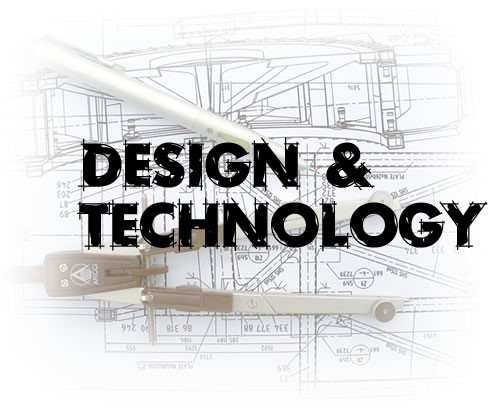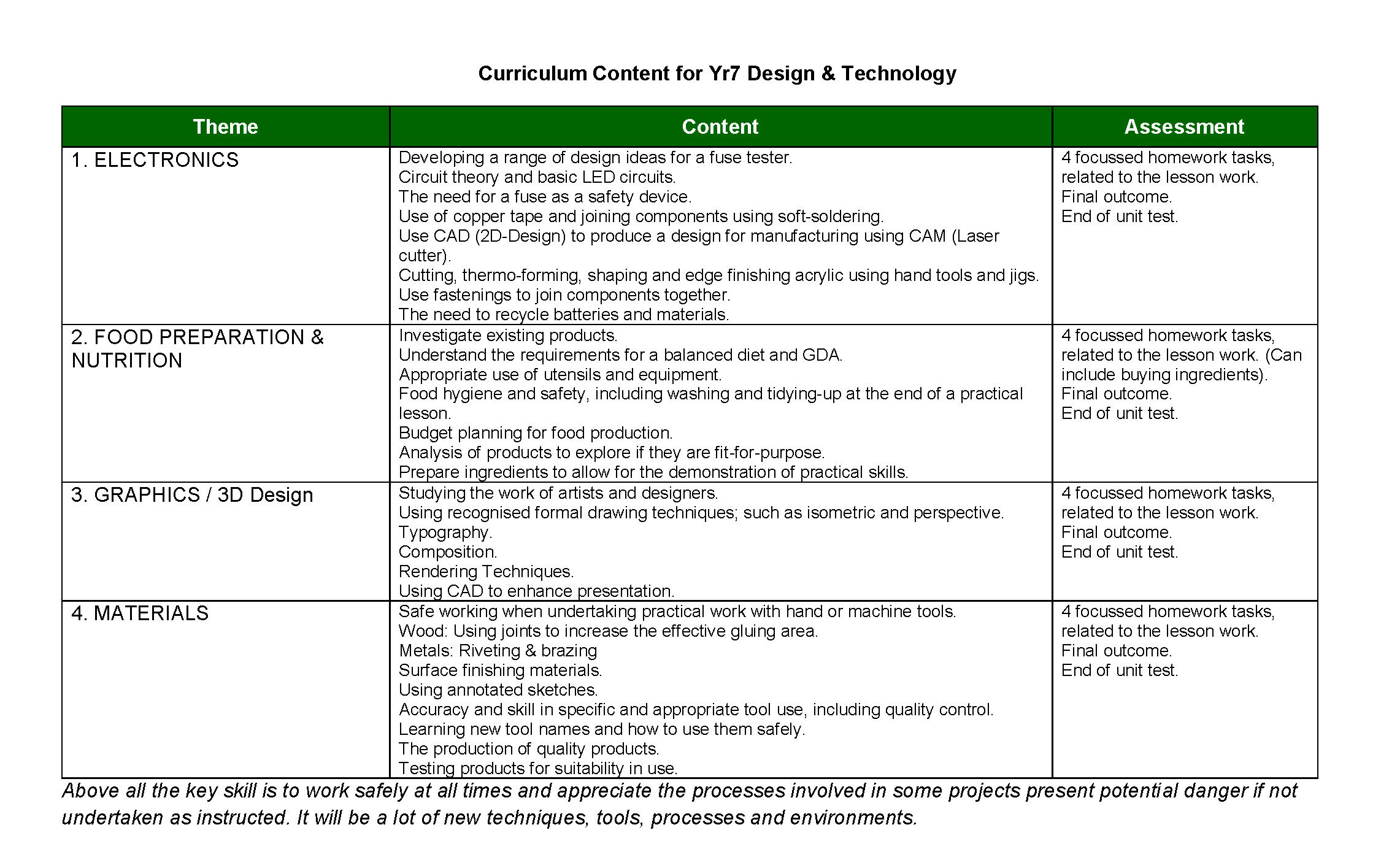Design & Technology

Design and technology is an inspiring, rigorous and practical subject. Using creativity and imagination, pupils design and make products that solve real and relevant problems within a variety of contexts, considering their own and others’ needs, wants and values. They acquire a broad range of subject knowledge and draw on disciplines such as mathematics, science, engineering, computing and art. Pupils learn how to take risks, becoming
resourceful, innovative, enterprising and capable citizens. Through the evaluation of past and present design and technology, they develop a critical understanding of its impact on daily life and the wider world. High-quality design and technology education makes an essential contribution to the creativity, culture, wealth and well-being of the nation.
Year 8 Curriculum Content
|
Theme |
Content/unit of work |
Assessment |
|
1. ELECTRONICS |
MP3 Amp in a can: The project as the assembly of three component parts, one of which will be made and evaluated – (circuit) and two which will be designed, made and evaluated (wrapper and top designs). · Circuit Theory -recap Y7 and Introduce concept of amplifier- force/ power/ current and voltage. circuit symbols- loudspeaker, capacitor, polarised capacitor and amplifier. The amplifier is, in itself a whole circuit -an “integrated circuit” or IC, or “chip” -which is polarised component along with the loudspeaker, the LED and the electrolytic capacitors · Practical Circuits -the PCB introduced and explained. · Production of circuit, testing and evaluation. Recap soldering theory- mechanical and electrical combination of METAL parts, H&S and clean soldering iron tips and good contact. Using “third/helping hands” device to help place and solder on-board components (not loudspeaker/LED/battery clip) clipping off excess legs from the solder side. Fault finding · Wrapper (“label”) design, manufacture and evaluation -Produce a Design Specification. Model the design and analysis of wrapper idea. Produce a Range of developed wrapper ideas -using iterative design approach. Use 2DDesign software to produce/print their chosen design. Evaluation their design to the specification and for “quality”. · Top panel (speaker holder) design, manufacture and evaluation -using 2D design software (CAD) and laser cutter to produce it (CAM) · Assembly of project and testing/evaluation overall against specification. |
4 focussed homework tasks, related to the lesson work. Final outcome. End of unit test. |
|
2. FOOD PREPARATION & NUTRITION |
Lunches: Refresh/Revisit knowledge of hygiene and safety. Produce a balanced tasty meal suitable for lunch. Produce a time plan to follow to ensure efficient use of time. Understand the functions of the nutrient groups in the body. Read and interpret any food labels Understand what the legal requirements are. Understand how meat reaches our table the names of the different meat cut types. Understand why recipes may need to be adapted and how they can adapt them. Know the types of milk and how its processed and what are the alternatives. Understand the function of ingredients used in making shortcrust pastry. Look at British cuisine and traditional/ regional recipes, ingredients and methods. · Make pizza and salad within the time frame allowed. · Make home-made soup or ‘all in one’ hot dogs · Make BBQ chicken wraps, which includes marinating and heat control. · Make shortcrust pastry cheese triangles using the ‘Rubbing – In’ method |
4 focussed homework tasks, related to the lesson work. (Can include buying ingredients). Final outcome. End of unit test. |
|
3. 3D DESIGN (GRAPHICS) |
Design modular housing : To help solve the UK housing shortage and perhaps be an affordable home for them to live in one day. The challenge is that our factory can only manufacture one shape or ‘unit’ and we need to prove to investors/potential buyers of the houses that they can be configured and finished in different ways to looks unique. · Introduction / isometric practice – practice isometric skills in preparation for the design tasks focus upon making designs look 3D · Initial Ideas and design development- Drawing different ideas for how the single unit could be stacked in different ways using two or three of the same shape or ‘unit’ -drawn in a scale. Once done, details can be drawn in heavier pencil of where doors and windows might be, balconies and pergolas could go and how the garden might look, etc. · Final Design -Isometric Master Drawing, Tracing Final Design, Drawing Detail of Final Design · Continuation of the work on the final design, sketching in details of doors, windows, balconies, etc. Colour / Render · Extension Tasks – Build a Tower Block on ‘portrait’ isometric paper, adding detail and colour as necessary. Google SketchUp |
4 focussed homework tasks, related to the lesson work. Final outcome. End of unit test. |
|
4. PRODUCT DESIGN (MATERIALS) |
Grabber/litter picker Project: To develop knowledge of anthropometrics, mechanisms and linkages together with developing their designing and manufacturing skills through the design and manufacture of novelty grabber designed for sale in a souvenir shop such as Monkey World or other appropriate location. The grabber will be constructed largely of manufactured board (MDF) with a shaped handle and trigger based upon a template, a ‘head’ (jaws) that will be designed along an appropriate theme decided upon by the student. Ongoing testing against a set criteria with evaluation is an important aspect of this project. Students must use appropriate annotated sketches, in the form of sequence diagrams, to record specified processes during this module. The other focus will be to increase their awareness of Health and Safety in a workshop environment and produce a high-quality functioning outcome that can be practically tested · Safe working when undertaking practical work with hand or machine tools. · Mechanisms -levers, linkages, cams/cranks, gears, pulleys · Design development and using annotated sketches. · Accuracy and skill in specific and appropriate tool use, including quality control. · The production of quality products. · Testing products for suitability in use. |
4 focussed homework tasks, related to the lesson work. Final outcome. End of unit test. |

